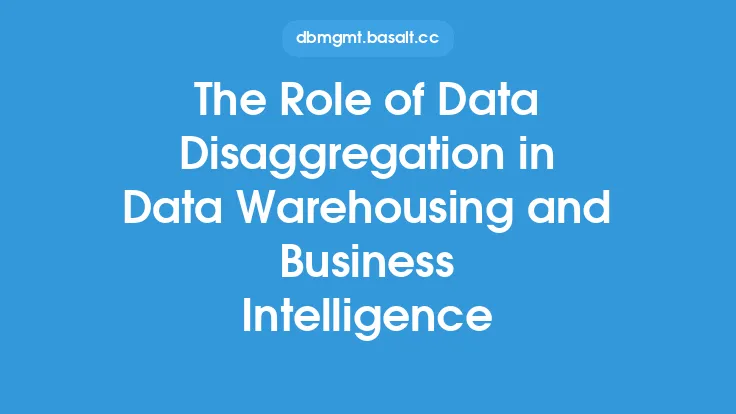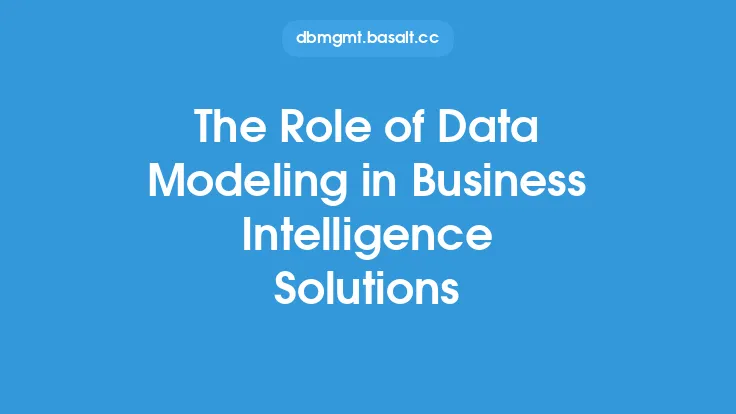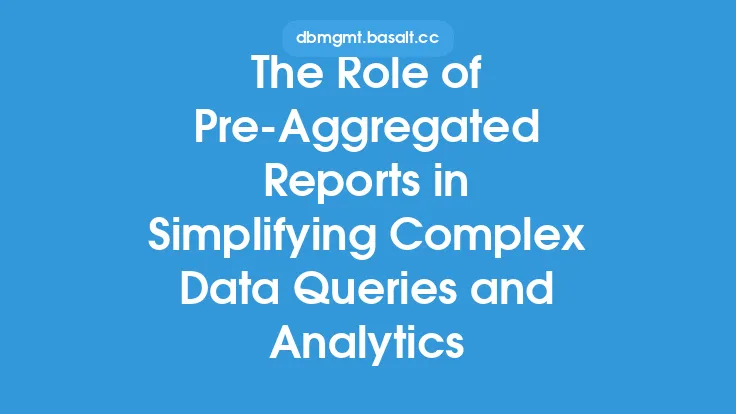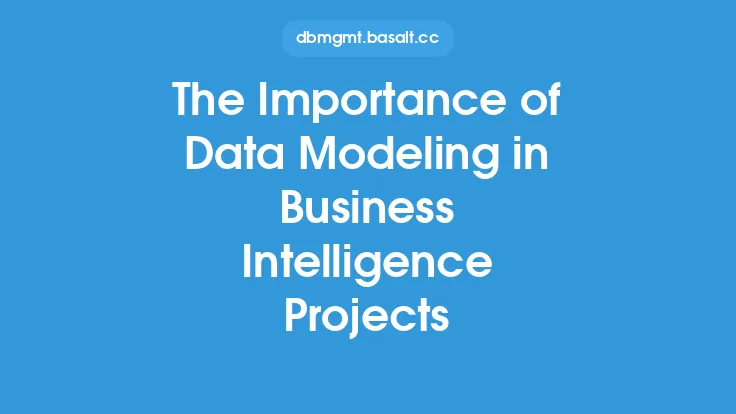Data aggregation plays a crucial role in the process of data warehousing and business intelligence, as it enables organizations to collect, organize, and analyze large amounts of data from various sources. The primary goal of data aggregation is to transform raw data into meaningful information that can be used to support business decisions. In this context, data aggregation involves the use of various techniques and tools to combine data from multiple sources, eliminate duplicates, and summarize the data into a more compact and meaningful form.
Introduction to Data Aggregation in Data Warehousing
Data warehousing is a process that involves the collection, integration, and analysis of data from various sources to support business decision-making. Data aggregation is a critical component of data warehousing, as it enables organizations to transform raw data into a more meaningful and useful form. The data aggregation process involves the use of various techniques, such as rollup, drill-down, and grouping sets, to combine data from multiple sources and summarize it into a more compact form. This enables organizations to analyze large amounts of data and identify trends, patterns, and relationships that can inform business decisions.
The Benefits of Data Aggregation in Business Intelligence
Data aggregation provides several benefits in the context of business intelligence, including improved data quality, increased data consistency, and enhanced data analysis. By aggregating data from multiple sources, organizations can eliminate duplicates, correct errors, and transform raw data into a more meaningful and useful form. This enables organizations to make more informed decisions, as they are based on accurate and reliable data. Additionally, data aggregation enables organizations to analyze large amounts of data and identify trends, patterns, and relationships that can inform business decisions.
Data Aggregation Techniques
There are several data aggregation techniques that can be used in data warehousing and business intelligence, including rollup, drill-down, and grouping sets. Rollup involves the aggregation of data from multiple sources into a single, summary value. Drill-down involves the analysis of detailed data to identify trends, patterns, and relationships. Grouping sets involve the aggregation of data into groups based on common characteristics, such as customer demographics or sales regions. These techniques enable organizations to transform raw data into a more meaningful and useful form, and to analyze large amounts of data to identify trends, patterns, and relationships.
Data Aggregation Tools and Technologies
There are several data aggregation tools and technologies that can be used in data warehousing and business intelligence, including data warehousing software, business intelligence software, and data integration tools. Data warehousing software, such as Oracle and IBM, provides a platform for collecting, integrating, and analyzing data from various sources. Business intelligence software, such as Tableau and Power BI, provides a platform for analyzing and visualizing data to support business decision-making. Data integration tools, such as Informatica and Talend, provide a platform for integrating data from multiple sources and transforming it into a more meaningful and useful form.
Best Practices for Data Aggregation
There are several best practices for data aggregation in data warehousing and business intelligence, including data quality, data consistency, and data security. Data quality involves ensuring that the data is accurate, complete, and consistent. Data consistency involves ensuring that the data is formatted consistently across all sources. Data security involves ensuring that the data is protected from unauthorized access and use. Additionally, organizations should establish clear policies and procedures for data aggregation, and should provide training and support to users to ensure that they understand how to use the data aggregation tools and techniques effectively.
Challenges and Limitations of Data Aggregation
There are several challenges and limitations of data aggregation in data warehousing and business intelligence, including data complexity, data volume, and data variety. Data complexity involves the complexity of the data, including the number of sources, the format of the data, and the relationships between the data. Data volume involves the large amounts of data that must be aggregated and analyzed. Data variety involves the different types of data that must be aggregated and analyzed, including structured and unstructured data. Additionally, organizations may face challenges in terms of data quality, data consistency, and data security, which can impact the accuracy and reliability of the aggregated data.
Future of Data Aggregation
The future of data aggregation in data warehousing and business intelligence is likely to involve the use of advanced technologies, such as artificial intelligence and machine learning, to automate and optimize the data aggregation process. Additionally, the use of cloud-based data warehousing and business intelligence platforms is likely to become more prevalent, as they provide a scalable and flexible platform for collecting, integrating, and analyzing large amounts of data. Furthermore, the use of real-time data aggregation and analytics is likely to become more widespread, as it enables organizations to respond quickly to changing business conditions and make more informed decisions. Overall, the future of data aggregation is likely to involve the use of advanced technologies and techniques to transform raw data into meaningful information that can be used to support business decision-making.





